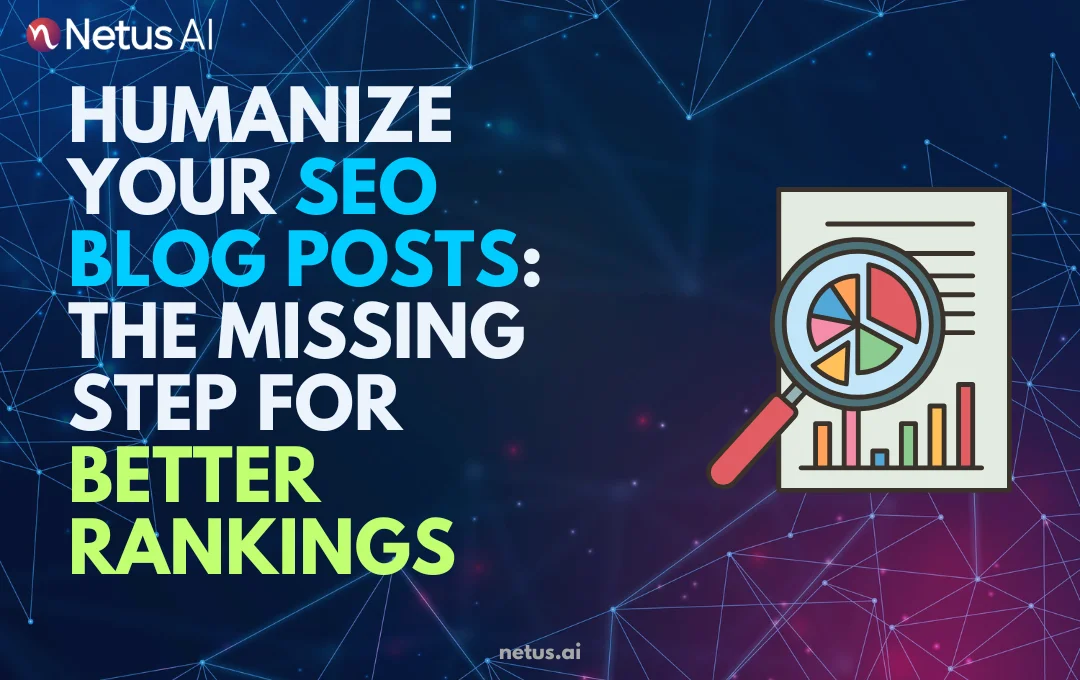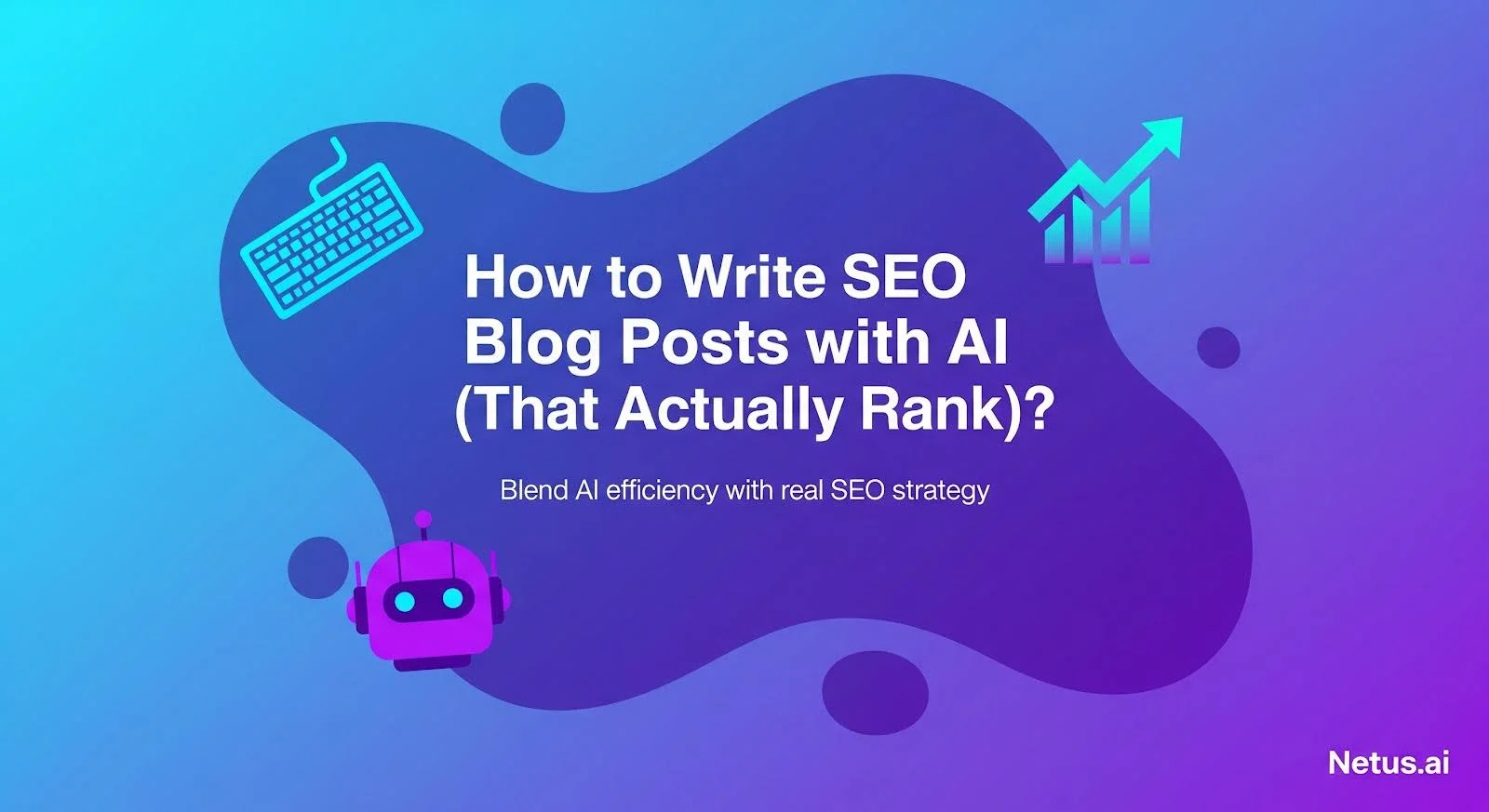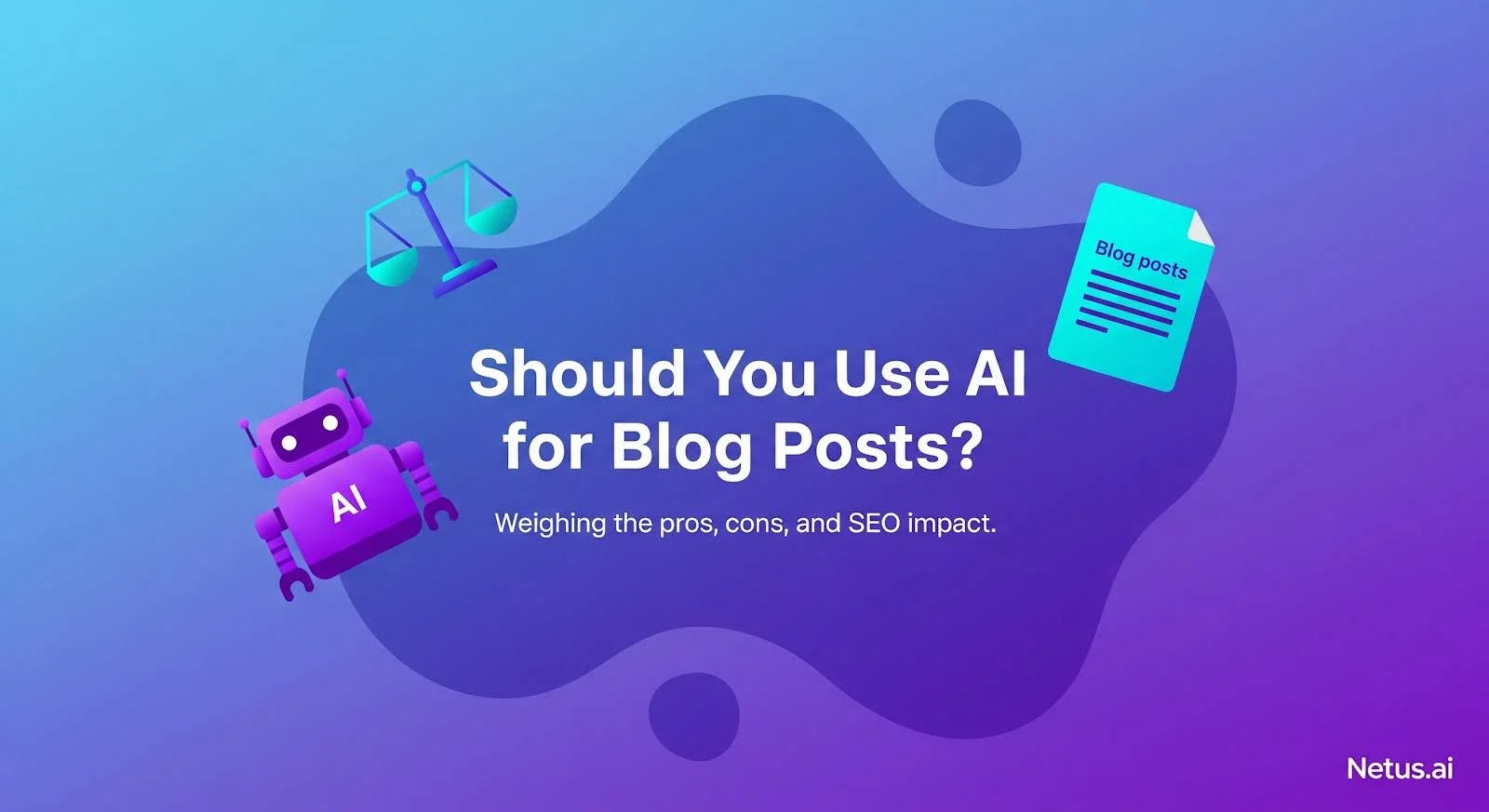Staring at a blank page with three blog posts due this week and SEO targets looming, you turn to an AI writer for quick content.
Paragraphs, structure, and keywords appear instantly. Relief is short-lived. A week post-publish, traffic hasn’t improved, maybe dipped. A fear whispers: Did Google flag this AI-generated content?
The speed of AI is powerful, but its raw output is becoming a major SEO liability, a tightrope walk over a ranking abyss.
The double-edged scalpel: Why raw AI blogging is riskier than ever?
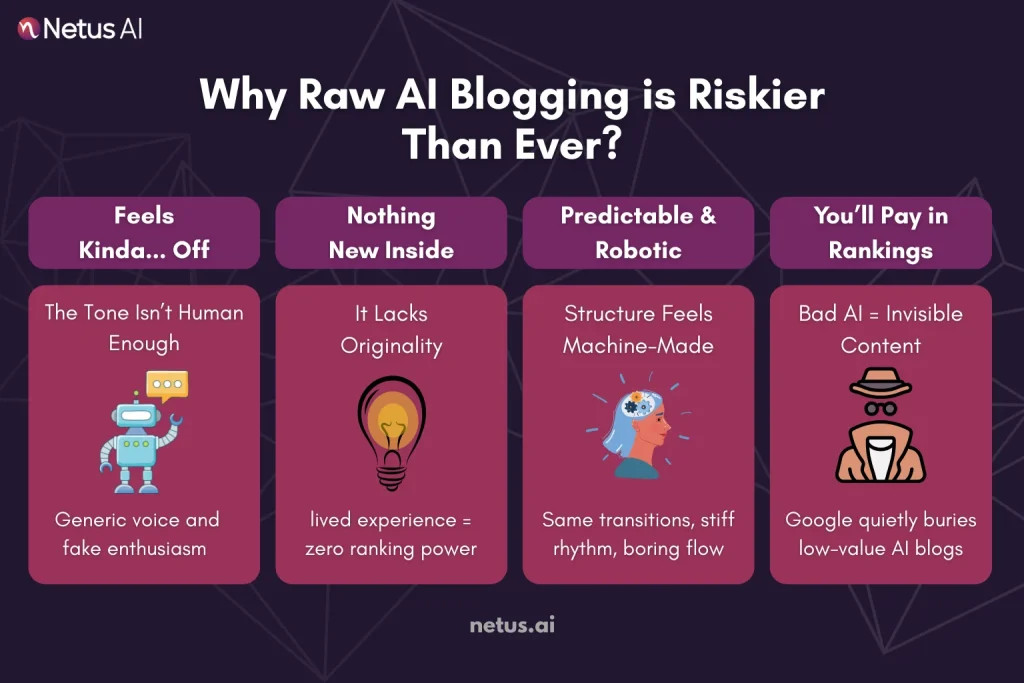
There’s no denying the revolution. AI writing assistants have flooded the content landscape.
The allure is potent: scale content production exponentially, slash research time, maintain consistency and theoretically free up human minds for “higher-level” tasks. For overwhelmed marketers and SEOs, it feels like catching a wave. Google prioritizes helpful, reliable, people-first content (Helpful Content Update, EEAT).
Raw AI-generated content often conflicts with these principles because AI struggles with what makes content truly human and valuable.
- The uncanny valley of tone: It sounds almost human, but not quite. The voice is often generic, blandly informative or unnervingly enthusiastic without depth. It lacks the subtle nuances, the authentic hesitations, the brand-specific personality or the lived-in wisdom that resonates.
It’s content that feels manufactured, not shared. Readers sense this artificiality instantly, leading to higher bounce rates and lower engagement, strong negative signals for Google. - The originality abyss: AI is a masterful synthesizer of existing information. It’s terrible at genuine originality. It rarely offers truly fresh perspectives, surprising insights born from real-world experience or unique angles that haven’t been rehashed across the web.
Its output often feels derivative, skimming the surface rather than diving deep. This directly contradicts Google’s push for original, insightful content that adds real value beyond what’s already ranking. - Structural stiffness: While AI can follow templates, its flow often feels mechanical. Sentence structures become predictable. Transitions are formulaic (“Furthermore,” “However,” “It is important to note”). Paragraphs lack the organic rhythm of human thought, the digressions, the emphatic fragments, the conversational flow that keeps readers hooked. This robotic structure is a glaring stylistic flag.
The consequence? Google’s algorithms, increasingly attuned to these signals, may flag AI content as unhelpful, low-value or simply not meeting user intent. This doesn’t always mean a manual penalty (though that’s possible), but often a quiet, demoralizing demotion. Your content sinks in the rankings, buried beneath pieces that simply feel more authentic and useful.
The initial time savings evaporate when you realize the content isn’t performing. Learning how to write blog posts with AI effectively means navigating these risks, not ignoring them.
Decoding the gatekeeper: Why Google raises the red flag on AI content?
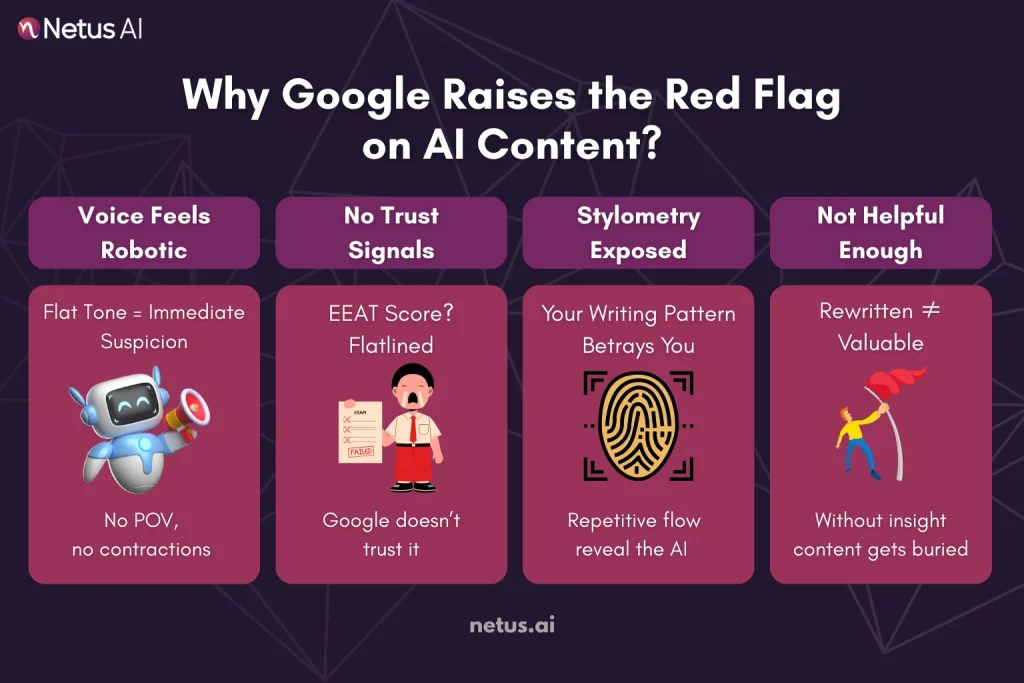
Understanding why Google might sideline your AI-generated masterpiece is crucial to fixing it. It’s not a simple vendetta against machines.
Google’s Helpful Content System is essentially a sophisticated quality control mechanism asking one core question: “Was this content created primarily for people or to manipulate search engines?”
Raw AI content often falls squarely into the latter category, even if unintentionally. Here’s what triggers the alarms:
- Robotic tone & lack of nuance: As mentioned, the unnatural voice is a primary giveaway. Google’s systems, likely incorporating advanced linguistic analysis similar to public AI detectors, can identify patterns indicative of machine generation. This includes overly formal language where it doesn’t fit, a lack of colloquialisms or natural contractions and an absence of emotional resonance or specific point-of-view.
- Thin value & missing depth (The EEAT killer):
Can users trust it, especially on important topics (YMYL – Your Money, Your Life)? Unlikely, if it feels shallow or generic. This failure across the EEAT spectrum is a fundamental reason content gets demoted.Does the content demonstrate real Experience or Expertise? Raw AI output inherently cannot. It parrots information but lacks the authority that comes from genuine practice or deep understanding.
- Predictable stylometry: This is the science behind many AI detectors. AI models, by their nature, develop statistical patterns in their writing: preferred sentence structures, over-reliance on certain transition words, predictable word choices, rhythmic uniformity.
Humans are messier, more varied. Tools (and likely Google’s internal systems) analyze hundreds of linguistic features to calculate a probability score. Highly predictable patterns scream “machine.”
- Structural awkwardness: Machine-generated lists or overly rigid templates with poor flow raise suspicion. Content may cover points but fail to guide the reader. Headings might be keyword-stuffed instead of informative.
- Lack of original research or perspective: Simply rephrasing the top 10 search results offers nothing new. Google rewards unique value: original data, case studies, personal anecdotes, expert interviews, and novel analysis. AI alone cannot produce this.
Content starts at generation: NetusAI’s SEO article writer and content generator
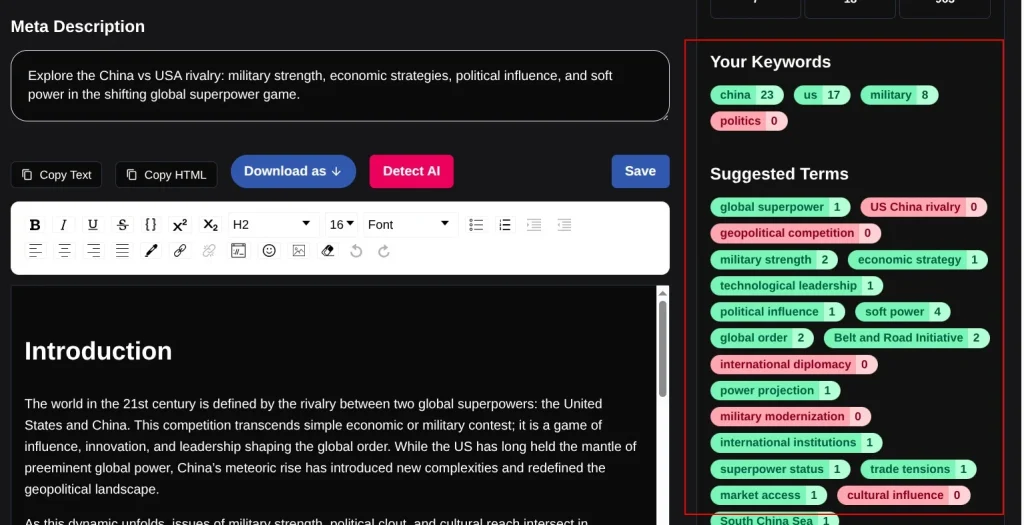
Avoiding stylometry and detection issues shouldn’t begin after content is written, it should start with the writing itself. That’s where NetusAI steps in.
Unlike generic AI tools that churn out robotic, easily flagged paragraphs, The NetusAI SEO Article Generator is designed to help you create full-length blog posts that are already optimized for clarity, tone and search intent. Unlike generic tools, it goes beyond simple drafting. It:
- Lets you input headlines and targeted SEO keywords
- Supports long-form templates for full blogs
- Auto-generates a structure with Title → Outline → Content
- Works in multiple languages for global teams
And most importantly, it ties directly into the Netus AI Bypasser + Detector system, meaning your output isn’t just readable, it’s already tuned to avoid detection.
You can generate, review and rewrite all in one interface without needing third-party tools to patch the gaps. It’s built for marketers, freelancers and bloggers who want their AI content to actually pass as human-written.
Content Generator
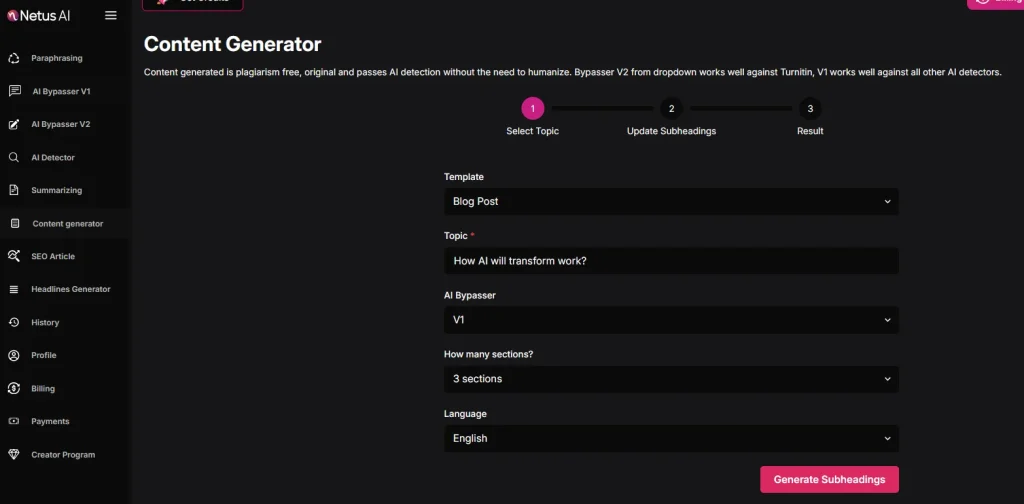
NetusAI also offers a Content Generator. Following the simple steps as shown on the user-friendly NetusAI page, Plagiarism Free Content will be generated from the beginning. The result generated can be downloaded and copied directly as well. Users can easily view their results as they will be stored in the history tab.
So whether you’re starting from scratch or turning an idea into a full SEO article, NetusAI saves you time and rewrites, without sacrificing trust or quality.
Final Thoughts
Writing with AI isn’t the problem, publishing without refinement is. Google doesn’t penalize AI-written content; it penalizes unhelpful content. If your blog sounds robotic, lacks insight or feels formulaic, it’ll get flagged whether AI wrote it or not. The key is humanization. Add real value. Inject your voice. Restructure for rhythm.
That’s why the smart play is hybrid creation, with NetusAI, you can:
- Write with structure using the SEO article writer
- Plagiarism free Content generator
- Detect and fix red flags with the AI bypasser
Or you can start with AI, humanize with Netus AI, then finalize with human judgment. This approach gives you the speed of automation and the trustworthiness Google demands.
FAQs
Content from AI usually sticks to the same old sentence patterns over and over and it can feel a bit off, not quite like human writing. Systems run by Google catch those repeating habits and label it as low quality.
People usually recommend putting your writing through AI detection tools first. Ones like the checker that’s built right into NetusAI can help spot issues. If certain parts come up as flagged, just rewrite those specific areas. Run the test all over again after that.
No. Google does permit the use of AI to assist in writing. This works as long as the material stays original and helpful. The main thing that counts is the overall quality of the work.
NetusAI is one of the most effective tools. It offers both rewriting and real-time detection features, helping writers produce content that reads naturally and passes AI detection checks.
No. This is a common myth. Errors may trick basic detectors but destroy readability and trust. Instead, focus on rewriting with a natural voice, like NetusAI’s paraphraser does.


